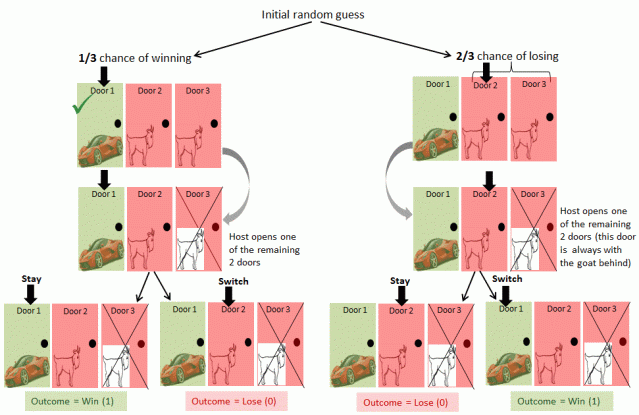 Heard of the American game show “Let’s Make a Deal”? For those who don’t know, let me describe the game show in short.
Heard of the American game show “Let’s Make a Deal”? For those who don’t know, let me describe the game show in short.
As a contestant on the game show, you are told that behind one of the three closed doors lies a brand new Ferrari and there is a goat behind each of the other two doors. Now you have to choose (not yet open) one of the three doors. After you have selected one door (not yet opened), the host opens one of the remaining two doors (where there is no Ferrari). Now the host asks you if you would like to change your choice of the door to the last remaining door? (door which is not opened nor chosen). So now what is your best strategy to maximize the chances of winning the Ferrari:
A] Stay with the original guess (choice)
B] Switch your guess (choice) after the host opens the other door
Before you start reading the solution below, think and decide your strategy. (go back to your school/college mathematics and try and remember some probability concepts J)
I hope you have made your choice from the above alternatives. Most people instinctively think that there is a 50-50 chance of winning the Ferrari and it doesn’t really matter if you stay with your original choice vs. if you switch your choice. This is essentially the famous ‘Monte Hall’ problem. Let me break this instinctive illusion and tell you that switching the door actually has a higher probability of winning (2/3) than staying with your original choice (1/3). I realize that this seems to be very contradictory so I have come up with an illustration which will help you understand how these probabilities change on switching the door. I personally find the ‘Tree Diagram’ approach to solve any probability problem very easy. So I have attempted to explain the solution to the above problem with the help of a ‘Tree Diagram’.

Take a few minutes and go through the above ‘Tree Diagram’. We will now calculate the ‘Expected Value’ of the outcome. For a random variable (X), the expected value of this random variable is:

Substituting in the above formula
Stay = (1/3 * 1) + (2/3 * 0) = 1/3
Switch = (1/3 * 0) + (2/3 * 1) = 2/3
Thus we have proven mathematically that you should ‘Switch the door’ every time to maximize the chances of winning the Ferrari in the long run! One more important point to note here is that we are talking in terms of probability so there is still no guarantee that switching the door will always make you win. The way you can interpret this is: for example if you play this game 300 times, you will on an average end up winning 200 times (2/3 * 300) on switching the door.
Having said all this, there are still many folks who vehemently argue that the probability of winning is same (50-50) and it doesn’t matter if you switch the door or not at the second chance.
After reading this if you are still not convinced with the change in probabilities after switching the door, I have a R-Code in which by using Monte-Carlo simulations you can prove the change in probabilities of winning after switching the door at the second chance. Please mention your email-id in a comment below so that I can share the R-Code with you. Also, I would like to hear your opinion on the above explanation.
Follow bicorner.com on Twitter, Facebook & Google+
 Authored by:
Authored by:
Sharayu Rane
Sharayu Rane works as a Business Analyst at ZS Associates. As a Business Analyst, Sharayu has expertise in leveraging various complex and huge data to help clients track their brand performance, develop insights into clients’ business. Also, Sharayu volunteers as a Data Analyst at Safecity. Safecity is a non-profit organization based out of Mumbai, India which crowd sources personal stories of sexual harassment and abuse in public spaces. Sharayu’s current role involves using advanced predictive modelling techniques to predict the location/city where the incident took place as it often happens that people don’t mention the incident of the location/city.
Categories: Articles, Education & Training, Featured, Sharayu Rane



Easy to explain.
1/3 chance of picking the car. Switch, you lose 1/3 of the time.
2/3 chance of picking the goat. Switch and you win (Monte eliminates the other goat) 2/3 of the time.
LikeLiked by 1 person
I’d like to see your R code.
LikeLike
Sure, could you share your email id?
LikeLike
sachdt.69@gmail.com
LikeLike
I have shared the R code.
LikeLike